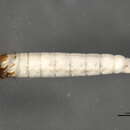Comprehensive Description
provided by Smithsonian Contributions to Zoology
Brachycentrus (Sychnothrix) echo (Ross)
Oligoplectrum echo Ross, 1947:164.—Wiggins, 1965:1094; 1977:62.
The adult males of this species are easily recognized by their genital structure, especially the tenth tergum and lateroventral lobe of the clasper. The tenth tergum is very unusual with what would appear to be a rather typical bilobed tergum, but then there is a single lobe above the tergum on the midline and a second lobe between the two halves. There is, here and there in the family, a pair of lobes above the tenth tergum (e.g., B. americanus (Banks)), but no species with lobes on the midline. It is tempting to speculate that perhaps the paired lobes of B. americanus have rotated 90° and now lie on the midline. Some support for this idea is provided by a close examination of the lobes. The more ventral one arises from either the right or left tergal half, not from precisely the middle, and the base of the dorsal lobe also appears to be ever so slightly asymmetrical.
The larvae are typical Brachycentrus Curtis in structure, but construct a slender, tapered, sandgrain case. This type of case is uncommon in Brachycentrus Curtis, being known only in B. maculatus (Fourcroy) and B. etowahensis Wallace. It is interesting that B. echo (Ross) and B. etowahensis are also the only two species with rows of setae on the faces of the mid- and hindfemora. The case structure coupled with the non-carinate head, single pair of submesal, first sternal setae, and rows of setae on the anterior and posterior faces of the mid- and hindfemora provide easy recognition of the larvae.
ADULT.—Length of forewing, 5.5–6.5 mm, 7.5–8 mm. Color in alcohol, brown. Male abdomen with seventh sternum bearing a broad posteromesal lobe, about as long as broad.
Male Genitalia: Ninth segment without an anteroventral lobe. Cerci elongate, mostly fused dorsomesally, with ventrolateral margin strongly sclerotized and with a basal sclerotized bar. Tenth tergum elongate, composed of a pair of lateral sclerites, rounded apically, between which lies a single more rodlike lobe and which is surmounted by another mesal, clavate lobe. Clasper with basal area small, straight, lateroventral margin produced into a large, distinct lobe; apex bluntly pointed in ventral aspect.
LARVA.—Length to 7.5 mm. Sclerites yellow brown; head with darker areas posteriorly on frontoclypeus and genae with a distinct paler area around area of junction of dorsal ecdysal lines, muscle scars distinctly paler; legs yellow brown with dorsal margin of mid- and hindfemora fuscous. Femora of mid- and hindlegs with a single apical seta on ventral margin; anterior and posterior faces with rows of 2–5 stout setae; apicoand basodorsal setae large, others lacking; ventral margin with a uniform setal fringe. Tibiae with a single basoventral seta. One pair of large, submesal setae on venter of first abdominal segment. Lateral fringe present posteriorly on segments 3–7. Gills single, in dorsal and ventral rows.
TYPE MATERIAL.—Holotype, male, INHS, published as “Hot Creek, Mono County, California; May 1, 1937; H.J. Rayner.” Type not seen; topotypes studied.
MATERIAL EXAMINED.—USA, CALIFORNIA, Mono Co., Hot Creek, 35 mi. N Bishop, 16 Jul 1966, G.B. Wiggins, 5, 1, 5 larvae, 2 pupae.
UTAH, Heber, 14 Aug 1943, Knowlton & Maddock, 1 paratype. Garfield Co., Assay Creek, Hwy. 89, 16 Jul 1959, R.W. Baumann, 4. Sevier Co., Clear Creek, Clear Creek, Hwy. 89 at Sevier, 21 Jul 1968, R.W. Baumann, 1. Summit Co., Yellow Pine Creek, 7 mi. E Kamas, 28 Jul 1973, B. Stark, 1. Summit Co., Weber River, 1 mi. NW Peoa, 28 Jul 1973, B. Stark, 24, 4.
Sphinctogaster Provancher, 1877:262.
Brachycentriella Iwata, 1927:215.
ADULT.—Spurs 2,3,3.
Male Genitalia: Ninth segment in lateral aspect with sternum barely or not at all produced anteriad. Cerci in dorsal aspect elongate, ovoid, completely separated mesally. Tenth tergum elongate, variously formed. Claspers elongate, semi-erect; apex variously formed, but never produced into a laterally developed lobe nor with a large mesally directed lobe.
LARVA.—Head and thoracic sclerites either uniformly brown or marked with a distinct color pattern. Mid- and hindfemora with a single, large seta on ventral margin, another on anterior face near apex, and a third on posterior face near base (B. etowahensis Wallace has several extra setae), setae of filtering fringe virtually uniform in structure and length; setae of dorsal margin of similar lengths. With two submesal pairs of setae on first abdominal sternum stout and conspicuous. Gills single.
TYPE-SPECIES: Sphinctogaster lutescens Provancher (monobasic).
- bibliographic citation
- Flint, Oliver S., Jr. 1984. "The Genus Brachycentrus in North America, with a Proposed Phylogeny of the Genera of Brachycentridae (Trichoptera)." Smithsonian Contributions to Zoology. 1-58. https://doi.org/10.5479/si.00810282.398

